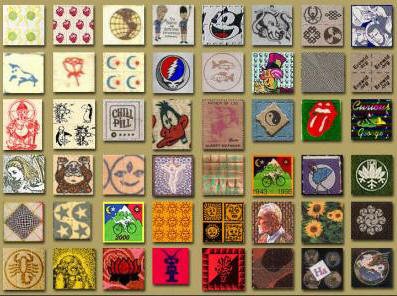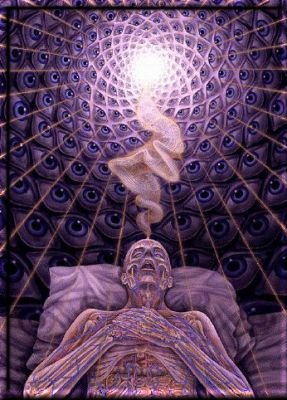Tryptamines
Tryptamines are naturally occurring alkaloids found in many plants, animals and even humans. Many neurotransmitters are tryptamines (for instance, serotonin and melatonin). There are several psychedelic drugs that fall into this category based on their chemical composition.
Psilocybin and Psilocin.
These are the primary psychoactive alkaloids in many species of mushrooms found in many parts of the world
Street Names : “shrooms” “magic mushrooms” “boomers”
Psychological Effects:
- Heightened sensory experiences and perceptual distortions (i.e. brighter colors, sharper visual definition, increased hearing acuity, more distinguished taste)
- Auditory, tactile, and visual hallucinations
- Synesthesia (melding of the senses: seeing music or hearing colors)
- Difficulty focusing, maintaining attention, concentrating, and thinking
- Impaired judgment and preoccupation with trivial thoughts, experiences, or objects
- Sense of detachment from body and surroundings and loss of boundaries between the two
- Altered perception of space and time
- Inability to distinguish fantasy from reality
- Melding of past experiences with present
- Feelings of unity with the environment
- Feelings of involvement with intense spiritual experiences
- Tension, anxiety, and restlessness
- Highly adverse reactions ("bad trip"), including frightening hallucinations, confusion, disorientation, paranoia, agitation, depression, panic, and/or terror
Physiological Effects
- Nausea, vomiting, abdominal cramps, and diarrhea
- Muscle relaxation, weakness, and twitches
- Yawning, drowsiness, dizziness, lightheadedness, and lack of coordination
- Pupil dilation, tearing, dry mouth, and facial flushing
- Increased heart rate, blood pressure, and body temperature
- Sweating followed by chills and shivering
- Numbness of tongue, lips, or mouth
- Feelings of physical heaviness or lightness and feelings of floating
^From Center For Substance Abuse Research, Psilocybin/Psilocin. http://www.cesar.umd.edu/cesar/drugs/psilocybin.asp
N,N Dimethyltryptamine (DMT)
DMT is a simple tryptamine alkaloid that is produced naturally by the human brain. It has also been used by the indigenous peoples of South America. Most commonly, it is extracted from plants and smoked or snorted
Street Names: “DMT” “business man’s special” “elf spice” “dimitri”
Psychological Effects:
- · extremely short, immersive, experience
- · brightly colored intense visual hallucinations (geometric patterns, Mayan or Aztec motifs and imagery)
- · “rushing” or “buzzing” audio hallucinations
- Extreme distortion of time (experiencing “eternity”)
Physical Effects:
- · large increase in blood pressure
- · increase in body temperature
- · mydriasis (dialated pupils)
- · large increase in heart rate
- · nausea
^ from DMT: The Spirit Molecule. A Doctor’s Revolutionary Research into the Biology of Near-Death and Mystical Experiences. Park Street Press, Rochester, Vermont. 2001. Pages 143-150
Lysergic acid Diethylamide (LSD)
LSD is easily the most commonly known psychedelic drug, and it too is a tryptamine. It is semisyntheticly derived from lysergic acid, which naturally occurs in ergot fungus as well as certain plants and flowers. It is extremely potent because threshold doses are around 25 to 30 micrograms or .025 mg. It is a very long lasting drug (up to 12 hours) and produces effects similar to psilocybin. It is commonly sold as a liquid or sugar cubes, paper and gelatin saturated in it.
Street Names: “acid” “syd” “doses” blotter” “lucy” “cubes” “tabs” “trips” “Alice D”
Psychological Effects:
- · stimulation
- · synesthesia (mixing of senses, tasting sounds or hearing colors)
- · visual hallucinations (geometric patters, imagery)
- · auditory hallucinations (echoing)
- · drastic distortion of time and space perception
- · experiencing “melting” or “merging” with surroundings
- · reliving past experiences
- · rapidly changing emotions
- · spiritual experiences
- · anxiety, panic attacks and paranoia
Physical Effects:
- · Increase in heart rate
- · Increase in body temperature
- · Increase in blood pressure
- · Increased perspiration
- · Increased saliva and mucus production
- · Nausea
- · Jaw clenching
- · Insomnia
^from http://www.erowid.org/chemicals/lsd/lsd_effects.shtml
Phenethylamines
Phenethylamines are natuarally occurring and synthetic chemicals, many of which are psychedelic. Mescaline, MDMA, Amphetamines, 2CB and many other common drugs are phenethylamines.
Mescaline
Mescaline (3,4,5-trimethoxyphenethylamine) is the most well known psychedelic phenethylamines, as is more commonly known as the primary psychoactive component of the cactus Peyote and the cactus San Pedro. Peyote and San Pedro have been and still are used by Native Americans in the southwestern United States and South America. It is sold rarely as crstyals and more commonly as peyote “buttons” or small dried pieces of cactus. Mescaline is rare and other drugs are often sold labeled as it.
Street Names: “cactus” “buttons” “mescal”
Psychological Effects:
- Vivid mental images and distorted vision
- Synesthesia: perception of seeing music or hearing colors
- Altered space and time perception
- Joy, exhilaration, panic, extreme anxiety, or terror
- Distorted sense of body (users can feel either weighed down or weightless)
- Heightened sensory experiences (i.e. brighter colors, sharper visual definition, increased hearing acuity, more distinguished taste)
- Difficult focusing, maintaining attention, concentrating, and thinking
- Loss of sense of reality; melding past experiences with present
- Preoccupation with trivial thoughts, experiences, or objects
- Highly adverse reactions ("bad trip"), including frightening hallucinations, confusion, disorientation, paranoia, agitation, depression, panic, and/or terror
Physical Effects:
- Numbness, tension, anxiety, rapid reflexes, muscle twitches and weakness, impaired motor coordination, dizziness, trembling, dilation of the pupils
- Increased blood pressure and heart rate
- Intense nausea and vomiting
- Appetite suppression
- Elevated body temperature and sweating
- Chills and shivering
Quoted from http://www.cesar.umd.edu/cesar/drugs/peyote.asp
2C-X
There are many newer, synthetic phenethylamines that are all structurally similar. “2C” comes from their chemical structure (specifically the location of carbon atoms), and the letter following it similarly describe chemical composition. 2C-B (4-bromo-2,5-dimethoxyphenethylamine) and 2C-I (2,5-dimethoxy-4-iodophenethylamine) and 2C-T7 (2,5-dimethoxy-4-(n)-propylthiophenethylamine) are among the most popular and all have very similar effects, the major differences between them being dose and duration. 2C-B, 2C-I and 2C-T7 are all structurally similar to mescaline as well. 2C-B is by far the most known and popular, so it will be focused on.
Street Names: “2C-B” “Nexus” “Seeing Bees” “Bromo” “toonies” “venus”
Psychological Effects:
- · Visual hallucinations (similar in character to those of mescaline or LSD)
- · Stimulation and an increase in energy
- · Euphoria
- · Altered sense of time and space
- · Synesthesia
- · Change in ability to communicate (increased ability for some, the opposite for others)
Physical Effects:
- · Increase in blood pressure
- · Increase in heart rate
- · Increase in body temperature
- · Increase in perspiration
- · Jaw clenching
- · Insomnia
Dissociatives
Dissociatives are a class of psychedelic drugs that are neither tyrptamines nor phenethylamines. They all have been used medically, and some are still used medically for various reasons. They are called dissiciatives because their primary effect is to create a sense of extreme disconnection from the user’s environment, often these experiences are similar to “out of body” and “near-death” experiences.
Ketamine
Ketamine is relatively common drug used as an anesthetic for animals and in some cases older people and children. It was used as a general anesthetic but this was discontinued due to the increase of reports of unwanted psychedelic experiences. The experience it creates is often referred to as the “K-Hole” because of the feelings of falling or moving, as well as the hallucinations that it produces (of tunnels or similar objects). It also has notoriety as a “date rape” drug because users in the “K-Hole” are often immobilized.*
Street Names: “Special K” Vitamin K” “Cat tranquilizer” “K”
Psychological Effects
- · Euphoria
- · Feelings of calm
- · Feeling connected to environment
- · Extreme distortion or perceived loss of sensory input
- · Visual and auditory hallucinations
- · Out of body experiences
- · Confusion
Physical Effects:
- · Ataxia (lack of muscle coordination)
- · Nausea
- · Loss of consciousness
- · Decrease in heart rate and respiration
*quoted from http://www.cesar.umd.edu/cesar/drugs/ketamine.asp
Phencyclidine (PCP)
Phencyclidine or PCP was first used as an anesthetic, but was discontinued for the same reasons the Ketamine was. It is well known for its reputation to make users act violently and aggressively, and to give them “superhuman strength”. PCP creates dissociation similar to that of Ketamine, but also creates aggressive and paranoid behavior, and due to the dissociation, users’ ability to perceive pain is severely impaired. It is often sold as a powder or in liquid form, in cigarettes or marijuana.
Street Names: “angel dust” “embalming fluid” “formaldehyde” “wet” “fry”
Psychological Effects*:
- Relaxation or drowsiness
- Feelings of unreality and dissociation with the environment
- Distorted sense of ones body, including a feeling of weightlessness
- Distorted sense of time and space
- Visual and auditory hallucinations and other sensory distortions
- Difficulty concentrating and thinking
- Anxiety
- Agitation
- Paranoid thoughts
- Confusion and disorientation
- Intense feelings of alienation
- Depression
- Bizarre or hostile behavior
- Obsession with trivial matters
- Grandiose delusions
- Panic, terror, and the overwhelming fear of imminent death
- Mild to intense euphoria
Physical Effects*:
- Impaired motor skills
- Blurred vision and constricted pupils
- Dizziness
- Painful reaction to sound
- Blank staring
- Speech disturbances, ranging from difficulty articulating to incoherent speech or inability to speak
- Muscular rigidity
- Decreased sensitivity and awareness of pain, touch, and position
- Stupor or coma
- Irregular heartbeat
- Alternately abnormally low and abnormally high blood pressure
- Slow, shallow, and irregular breathing
- Nausea
- Vomiting
- Salivation
- Increased body temperature and sweating alternating with chills and shivering
- Very high doses may result in an overdose and lead to coma, convulsions, or death
*quoted from http://www.cesar.umd.edu/cesar/drugs/pcp.asp
Dextromethorphan (DXM)
Dextromethorphan or DXM is a legal, over the counter medication used as a cough supressent, found in cough syrups. However, at higher doses is a dissociative similar in effect to both Ketamine and PCP. DXM use is prevalent among young adults and teens due to its availability and the amount of information on how to abuse available on the internet. At different doses DXM has different effects, but primarily, DXM is abused for its psychedelic properties.
Street Names: “Robotripping” “Poor man’s PCP” “Dexing” “DXM” “CCC” “skittling”
Psychological Effects:
- · Euphoria
- · Dissociation
- · Psychosis
- · Visual and auditory hallucinations
- · Out of body experiences
- · Delusions
- · Anxiety and fear
- Physical Effects:
- · Nausea and vomiting
- · Lack of coordination
- · Mydriasis
- · Dizziness
- · Diarrhea
- · Fever
- · Increase in blood pressure and heart rate
- · Body itching
- · Rash
Sources
http://www.streetdrugs.org/
http://www.drugabuse.gov/DrugPages/DrugsofAbuse.html
http://www.usdoj.gov/dea/concern/concern.htm
http://www.maps.org/w3pb/new/1960/1960_lebovits_1881_1.pdf
http://www.deadiversion.usdoj.gov/drugs_concern/dextro_m/dextro_m.htm
http://www.crimecommission.gov.au/content/publications/iddr_2005_06/Phenethylamines.pdf
Links
http://www.cesar.umd.edu/cesar/drug_info.asp
http://www.usdoj.gov/dea/concern/concern.htm
http://www.drugabuse.gov/DrugPages/DrugsofAbuse.html
http://www.streetdrugs.org/
http://www.drugfreepa.org/drugs/index.asp
http://www.deadiversion.usdoj.gov/drugs_concern/index.html
http://www.nida.nih.gov/drugpages.html
http://www.theantidrug.com/drug_info/drug_info_drugabuse.asp





